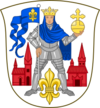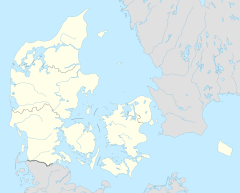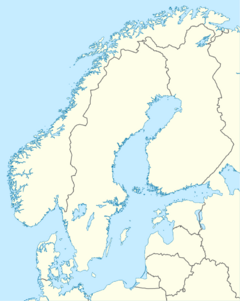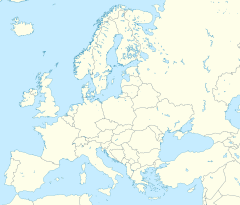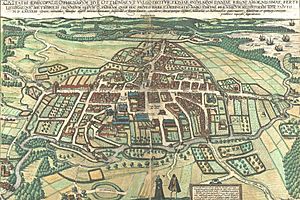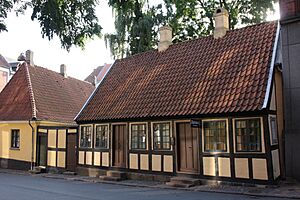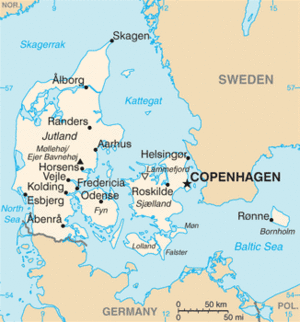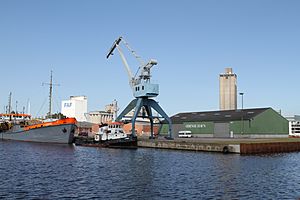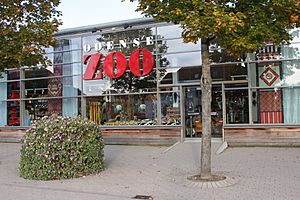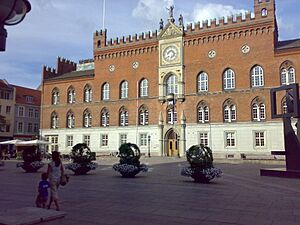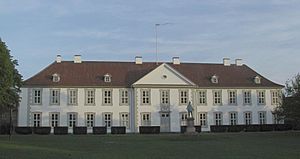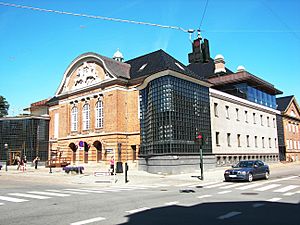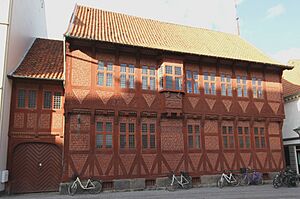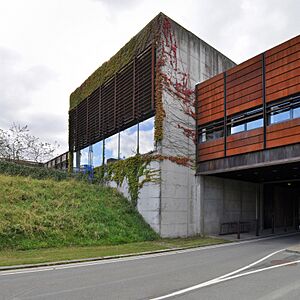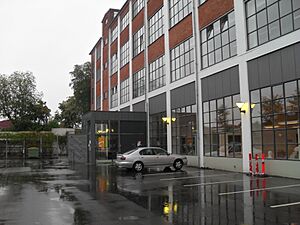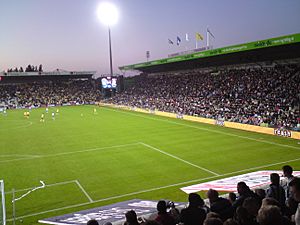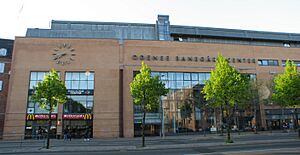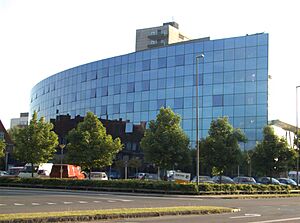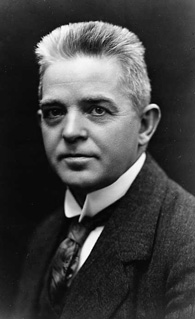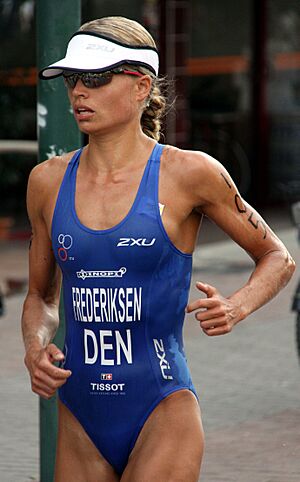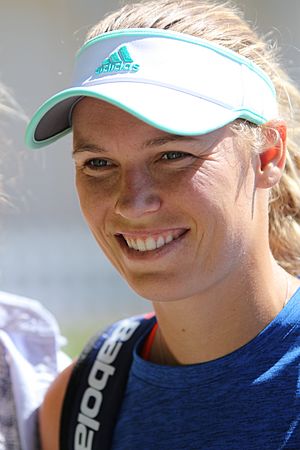Odense facts for kids
Quick facts for kids
Odense
|
||
|---|---|---|
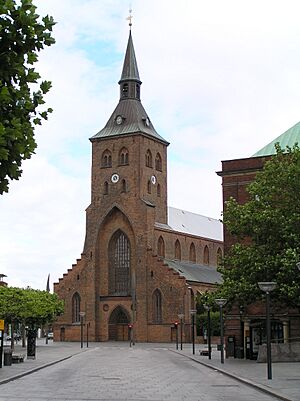
Odense Domkirke
|
||
|
||
| Country | ||
| Region | Southern Denmark (Syddanmark) | |
| Municipality | Odense | |
| Established | 988 | |
| City charter | 1355 | |
| Municipality | 1970 | |
| Area | ||
| • City | 79.30 km2 (30.62 sq mi) | |
| • Urban | 79.30 km2 (30.62 sq mi) | |
| • Metro | 3,481.30 km2 (1,344.14 sq mi) | |
| • Municipality | 305.60 km2 (117.99 sq mi) | |
| Elevation | 13 m (43 ft) | |
| Population
(2024)
|
||
| • City | 183,763 | |
| • Density | 2,294/km2 (5,940/sq mi) | |
| • Urban | 183,763 | |
| • Urban density | 2,317.31/km2 (6,001.8/sq mi) | |
| • Metro | 504,066 | |
| • Metro density | 144.79/km2 (375.0/sq mi) | |
| • Municipality | 209,078 | |
| • Municipality density | 684/km2 (1,770/sq mi) | |
| Demonym(s) | Odenseaner | |
| Time zone | UTC+1 (CET) | |
| • Summer (DST) | UTC+2 (CEST) | |
| Postal code |
5000–5270
|
|
| Area code(s) | (+45) 6 | |
| Website | www.odense.dk | |
Odense is the third largest city in Denmark. It is the biggest city on the island of Funen. As of 2024, about 183,763 people live in the city itself. The larger Odense Municipality has a population of 209,078. This makes it the fourth largest municipality in Denmark.
Odense is about 45 km north of Svendborg. It is 144 km south of Aarhus. The capital city, Copenhagen, is 167 km to the southwest. Odense was the main city of Odense County until 1970. From 1970 to 2007, it was part of Funen County. Now, it is part of the Region of Southern Denmark.
The city is famous for its connection to Hans Christian Andersen. He is known for his amazing fairy tales. He was born in Odense in 1805 and grew up there. People have lived in the Odense area for over 4,000 years. The city's name was first written down in 988. By 1070, it was already a busy city.
Canute IV of Denmark, often called the last Viking king, was killed in Odense in 1086. Even though the city was burned in 1249, it quickly recovered. It became an important trading center in the Middle Ages. Later, in the 18th century, big plans helped the city grow. They rebuilt Odense Palace and dug a canal to the Port of Odense. This made trade much easier.
In 1865, a large railway station was built. This helped the population and businesses grow even more. By 1900, Odense had 35,000 people. The Odinstårnet tower in Odense was one of Europe's tallest when built in 1935. But it was destroyed by the Nazis during World War II. The University of Southern Denmark started in 1966.
Today, Odense is still the main business center of Funen. It has many shops and important companies. These include the Albani Brewery and GASA, a big dealer of vegetables, fruits, and flowers. The city has Odense Palace, the Odense Theatre, and the Odense Symphony Orchestra. You can also visit the Hans Christian Andersen Museum. This museum is in the house where he was born.
In sports, Odense has many football clubs like OB. It also has the Odense Bulldogs ice hockey team. The city hosts the H.C. Andersen Marathon. You can travel to Odense through Hans Christian Andersen Airport or Odense station. The train station is on the main line between Copenhagen and Jutland.
Contents
- What's in a Name?
- A Look Back at Odense's History
- Where is Odense?
- People of Odense
- How Odense is Managed
- Odense's Economy
- Famous Places in Odense
- Learning in Odense
- Sports in Odense
- Getting Around Odense
- Healthcare in Odense
- Media in Odense
- Famous People from Odense
- Sister Cities
- Images for kids
- See also
What's in a Name?
The name Odense comes from Odins vé. This means "Odin's sanctuary." The area was once a special place for people who worshipped the Norse god, Odin.
A Look Back at Odense's History
Early Times
Odense is one of Denmark's oldest cities. Digs in the area show people lived here over 4,000 years ago. This dates back to the Stone Age. The first community was on higher ground. It was between the Odense River and a lake. Nonnebakken, a former Viking ring fortress, was south of the river.
Today, the Møntergården Museum in Odense has many items. These show the early Viking history of the area. Vikings built many forts along the river. They did this to protect against invaders from the coast.

The city turned 1000 years old in 1988. This marked the first time Odense's name was written down. It was in a letter from German Emperor Otto III in 988. The first church in Odense was likely St Mary's. It was probably built in the late 12th century.
Odense became a Catholic diocese in 988. By 1070, Odense was already a big city in Denmark. Canute IV of Denmark was killed in Odense in 1086. He was killed by angry peasants who disliked his high taxes. He became a saint in 1100.
In the early 12th century, monks from England started St Canute's Abbey. Here, a monk named Ælnoth wrote Denmark's first book. It was about St Canute. Many people visited Canute's shrine in Odense Cathedral.
The Middle Ages
Many churches and monasteries were built in Odense during the Middle Ages. St Canute's Church was built in the late 13th century. It was connected to a large monastery. Other old churches are St Mary's and St John's. Greyfriars Monastery was started by monks in 1279.
In 1247, Odense was burned by Abel of Denmark. This happened during a fight with his brother, King Erik IV. The cathedral had to be rebuilt. But the city still grew as a trading center. It got its city charter in 1335. Odense did well economically in the Middle Ages. Many merchants and craftspeople came to trade.
In 1482, the first book in Scandinavia was printed in Odense. It was a prayer book. After the Danish Reformation in 1536, the city had a good period. This lasted until the mid-1600s. Selling cattle was a main source of money. This helped build nice half-timbered houses for merchants. But the city's good times ended in the 1650s. Heavy taxes came after the Swedish Wars. The city then stopped growing until the late 1700s.
From the 1500s, Odense was a meeting place for parliaments. Until 1805, it was the main assembly for Funen. By 1700, Odense had about 4,000 people.
Growing and Changing
Big changes started in Odense in the 1700s. Plans were made to make the city modern. In 1720, King Frederick IV ordered Odense Palace to be rebuilt. A long canal was built from Odense Harbour to Odense Fjord. This was done between 1796 and 1806. It helped Odense become a bigger port city. This greatly increased its trade and population.
Odense Teater started in 1796. It is Denmark's first theater outside Copenhagen. It is also the country's second oldest. Odense Central Library opened in 1924. It moved to Odense station in 1995. The Odense Music Library has Denmark's largest collection of music recordings.
From the 1840s, the city grew quickly. It became Denmark's second largest city. Old city gates were taken down in 1851. Development spread south of the river. Making gloves became an important industry. The harbor was also made bigger. In 1853, Denmark's first modern water and gas works opened in Odense.
Trade got another boost when a railway was built in 1865. Odense became a major rail hub in Denmark. This was perfect for new industries. Many types of factories opened, making things like iron, textiles, and food. The city's population grew a lot. By 1900, it had 35,000 people.
Modern Times
Odense's most famous landmark was Odinstårnet (The Odin Tower). Built in 1935, it was Europe's second-tallest tower. Only the Eiffel Tower was taller. But Odinstårnet was blown up by a Danish Nazi group in 1944. It was never rebuilt. A small model now stands where the original tower was.
During World War II, Odense had a general strike in August 1943. This helped end cooperation with the Germans. Until the Danish industrial revolution, Odense was the second-largest city. But now, Aarhus has grown larger. From the 1960s, Odense became a cultural center. A university opened in 1966. Trade shows, like the Odense Congress Centre, also started. In 1988, a big national TV channel, TV2, was set up in Odense.
In 1988, a forest called Tusindårsskoven (The Thousand Year Forest) was planted. This was to celebrate the city's 1000th anniversary. In 2005, the city celebrated Hans Christian Andersen's 200th birthday.
The Odense Steel Shipyard closed in 2012. It was Denmark's largest shipbuilding place. It closed because of global competition. The land was sold to the Port of Odense. They are now building the Lindø Industrial Park there.
Where is Odense?
Odense is in the middle of the island of Funen. It is 45 km north of Svendborg. Aarhus is 144 km south, and Copenhagen is 167 km southwest. Suburbs of Odense include Stige to the north and Seden to the northeast.
The Odense River flows through the city. It runs south of the main shopping area. North of the city is the Odense Fjord. This fjord is connected by a canal to the Port of Odense. The small island of Tornø is in the fjord. Vigelsø is the largest island in the fjord. It is an important place for birds to breed.
Weather in Odense
Odense has a mild Oceanic climate. Summers are mild, with average high temperatures above 20 °C (68 °F). Winters are cold, with lows just below freezing. July and August are the warmest months. They also get the most rain. January and February are the coldest months. The Odense Fjord often has ice from January to March.
| Climate data for Odense (1971–2000) | |||||||||||||
|---|---|---|---|---|---|---|---|---|---|---|---|---|---|
| Month | Jan | Feb | Mar | Apr | May | Jun | Jul | Aug | Sep | Oct | Nov | Dec | Year |
| Record high °C (°F) | 11.2 (52.2) |
13.4 (56.1) |
18.5 (65.3) |
27.4 (81.3) |
28.8 (83.8) |
31.6 (88.9) |
33.4 (92.1) |
33.6 (92.5) |
27.7 (81.9) |
23.0 (73.4) |
15.8 (60.4) |
12.4 (54.3) |
33.6 (92.5) |
| Mean daily maximum °C (°F) | 3.1 (37.6) |
3.3 (37.9) |
6.1 (43.0) |
10.7 (51.3) |
16.0 (60.8) |
19.2 (66.6) |
21.3 (70.3) |
21.4 (70.5) |
16.9 (62.4) |
12.3 (54.1) |
7.4 (45.3) |
4.5 (40.1) |
11.9 (53.4) |
| Daily mean °C (°F) | 1.0 (33.8) |
1.1 (34.0) |
3.1 (37.6) |
6.6 (43.9) |
11.6 (52.9) |
14.7 (58.5) |
16.6 (61.9) |
16.5 (61.7) |
13.0 (55.4) |
9.2 (48.6) |
5.1 (41.2) |
2.5 (36.5) |
8.4 (47.1) |
| Mean daily minimum °C (°F) | −1.5 (29.3) |
−1.4 (29.5) |
0.1 (32.2) |
2.5 (36.5) |
6.7 (44.1) |
9.9 (49.8) |
11.7 (53.1) |
11.5 (52.7) |
8.9 (48.0) |
5.8 (42.4) |
2.4 (36.3) |
0.2 (32.4) |
4.7 (40.5) |
| Record low °C (°F) | −21.6 (−6.9) |
−20.0 (−4.0) |
−14.9 (5.2) |
−5.3 (22.5) |
−2.0 (28.4) |
1.7 (35.1) |
3.6 (38.5) |
4.2 (39.6) |
−1.4 (29.5) |
−4.1 (24.6) |
−16.2 (2.8) |
−20.0 (−4.0) |
−21.6 (−6.9) |
| Average precipitation mm (inches) | 48.5 (1.91) |
30.1 (1.19) |
39.6 (1.56) |
32.4 (1.28) |
41.1 (1.62) |
50.6 (1.99) |
50.0 (1.97) |
52.7 (2.07) |
56.7 (2.23) |
58.1 (2.29) |
53.3 (2.10) |
47.7 (1.88) |
560.9 (22.08) |
| Average precipitation days (≥ 0.1 mm) | 16.4 | 12.7 | 14.7 | 11.8 | 11.0 | 12.4 | 12.4 | 12.7 | 14.8 | 15.8 | 16.7 | 16.5 | 168.0 |
| Average snowy days | 6.0 | 4.4 | 3.9 | 1.1 | 0.0 | 0.0 | 0.0 | 0.0 | 0.0 | 0.0 | 1.6 | 3.3 | 20.9 |
| Average relative humidity (%) | 88 | 87 | 84 | 76 | 73 | 74 | 74 | 74 | 80 | 83 | 87 | 88 | 81 |
| Mean monthly sunshine hours | 40 | 61 | 124 | 179 | 258 | 265 | 256 | 224 | 175 | 101 | 44 | 28 | 1,755 |
| Source: Danish Meteorological Institute (humidity 1961–1990, sun 1931–1960) | |||||||||||||
People of Odense
Odense has been a populated town for a long time. In 1670, about 3,808 people lived there. By 1801, the population grew to 5,782. The number of people living in Odense increased a lot in the 1800s. It reached 30,268 by 1890.
With better trains and port facilities, Odense's population grew fast in the early 1900s. In 1901, there were 40,138 people. By 1935, it was 87,090. During World War II, the population went over 100,000. It kept growing after the war. In 1970, it reached 139,490. This was when Odense University opened.
People started moving from the city center to the suburbs. These areas became part of Odense Municipality in 1970. So, the city's population dropped a bit in the 1970s and 1980s. But it started growing again in the late 1980s. By 2017, it had 176,683 people.
How Odense is Managed
Odense Municipality is the group that runs the city. It also covers nearby towns and villages. The Odense City Council has 29 members. One of them is the mayor. The current mayor is Peter Rahbæk Juel. He is from the Social Democratic Party.
The city council's motto is At lege er at leve. This means "Playing is living." It shows their new way of thinking about learning and growth.
Odense's Economy
Odense is Funen's main industrial and business center. Its location in Denmark makes it a popular place for meetings and conferences. Companies here include the Albani Brewery and Kansas Workwear. In recent years, more jobs have moved from factories to service industries. By 2002, over half of the workers were in service jobs.
Lindø Wharf used to be Denmark's biggest shipbuilding place. Now, it's Lindø Industrial Park. It focuses on making parts for offshore industries. GASA, a large plant center, sells fruits, vegetables, and flowers. Denmark's main TV channel, TV 2, is based in Odense. It started in 1988.
The Rosengårdcentret shopping mall is in southeast Odense. It opened in 1971. It is Denmark's largest mall, with over 150 shops. You can find many stores in the city center too.
Tourism is important for Odense. In 2011, Odense Zoo was Funen's most popular tourist spot. It had over 400,000 visitors. The zoo opened in 1930. It has about 2,000 animals from 147 different types. In 2001, the zoo opened a big "Oceanium" with South American animals.
Odense is also known for robotics. Companies like Universal Robots and Mobile Industrial Robots (MiR) are here. The city has many new robot companies. The University of Southern Denmark has top robotics programs. The national drone test center is at Hans Christian Andersen Airport. Odense Robotics is a group for robot, drone, and automation companies. It has over 300 companies and nearly 20,000 workers. Odense is especially known for "co-bots," which are robots that work with people.
Famous Places in Odense
Nonnebakken is a hill in Odense. It was once a Viking ring castle. This fort helped control the Odense River. The remains of the fort were damaged when a building was put there in the late 1800s.
Churches
Odense is the home of the bishop of Funen. Saint Canute's Cathedral is one of Denmark's largest and most beautiful churches. It was built between 1081 and 1093. It was rebuilt in the 13th century in a Gothic style. The remains of Canute, Denmark's patron saint, are under the altar. The cathedral also has a famous altarpiece by Claus Berg. Kings Jens and Christian II are buried here.
St Alban's Church is the Roman Catholic church in Odense. It was built in 1908. Its tower is 54 meters (177 feet) high. St Mary's Church (Vor Frue Kirke) was built in the 13th century. It has a carved altarpiece from the 16th century. St John's Church was first mentioned in 1295. It was built by the Knights Hospitaller. It has a red brick tower.
Ansgars Church was the first church built in Odense since the Middle Ages. It was finished in 1902. The Peace Church (Fredenskirke) opened in 1920. It was named to celebrate the end of First World War.
City Hall
Odense's City Hall looks like a medieval Italian building. It was designed by Johan Daniel Herholdt and Carl Lendorf. It was finished in 1883. It uses red bricks and sandstone decorations. It stands where a smaller building from 1480 used to be. The building was made bigger in 1955. In 2005, the inside of the building was renovated. This was for Hans Christian Andersen's 200th birthday.
Palaces and Theatres
Odense Palace was built by King Frederick IV. He died there in 1730. It is now an office building. It stands where a 15th-century monastery used to be. The main part of the palace was finished in 1723. The King's Garden is next to the palace. It was designed in a French style.
Odense Teater started in 1796. It is Denmark's second oldest theater. It is one of the country's three main theaters. The original building was used until 1914. Then, a new building opened. It has three stages. The theater also has stages in an old sugar factory. It started the first drama school outside Copenhagen in 1941.
The Odense Symphony Orchestra started in 1946. It is one of Denmark's five regional orchestras. The orchestra plays in Odense Concert Hall. This hall opened in 1982. Most concerts are in the Carl Nielsen Hall. It can seat 1,212 people. Funen Opera (Den Fynske Opera) reopened in 1996. It focuses on modern operas in Danish.
Hans Christian Andersen's Legacy
Hans Christian Andersen was born in Odense in 1805. He is famous for his fairy tales. His birthplace is thought to be a small yellow house in the old town. In 1908, this house became the Hans Christian Andersen Museum. It shows his life from childhood to his writing career. It has items that tell about his friends and travels.
Andersen's childhood home is on Munkemøllestræde. He lived there from age two to 14. This house opened as a museum in 1930. It has tools his father used as a shoemaker.
Around the city, you can find many statues. They show characters from Hans Christian Andersen's stories. These include the Steadfast Tin Soldier and the Mermaid. There is also a special statue of Andersen in Eventyrparken (The Fairy Tale Park). It shows him with a book, ready to tell stories.
Museums to Explore
The museums in Odense are mostly run by the Odense City Museums. Funen's Art Museum is one of Denmark's oldest art museums. It started in 1885. It has works by famous Danish painters. The Funen Village (Den Fynske Landsby) is an open-air museum. It shows what country life was like in Denmark during Andersen's time. It has historic houses from Odense.
The Carl Nielsen Museum is about the life of Carl Nielsen. He was a famous composer. It also covers his wife, the sculptor Anne Marie Carl-Nielsen. The museum shows his childhood and his music career. You can see his violins and piano.
The Møntergården museum is about Odense's history. It is in one of the city's most famous Renaissance buildings. It was built in 1646. The museum has many items from Odense's early Viking history. It also shows the city in the Middle Ages and Renaissance.
The Danish Railway Museum is Denmark's national railway museum. It is the largest in Scandinavia. It opened in 1975 in an old engine shed. It has over 50 locomotives and railway cars. The oldest steam engine is from 1869.
The Brandts Museum of Photographic Art is Denmark's only national museum for photographic art. It opened in 1987. The Media Museum of Odense shows the history of free speech in Denmark. It also covers the printing press and Danish newspapers.
Learning in Odense
University of Southern Denmark
Odense University started in 1966. It was one of three new universities built to help the universities in Copenhagen and Aarhus. By the late 1900s, it had 11,000 students. In 1998, it joined with other schools to form the University of Southern Denmark (Syddansk Universitet).
The main campus of the University of Southern Denmark is in Odense. But it also has departments in other cities. With about 26,000 students, it is Denmark's third largest university. The Faculty of Engineering brings together several schools.
The Odense campus is known for having all its study programs in one place. This helps different subjects work together. By 2024, the university campus will connect to the new Odense University Hospital. This will help them work together on research. The combined university and hospital will be one of the largest buildings in Europe.
Other Schools
Odense also has parts of the UCL University College. This college is renovating its buildings in Odense. It plans to open University College Lillebælt Campus Odense.
The Lillebaelt Academy of Professional Higher Education started in 2009. It helps students get jobs in business. It had 3,200 students in 2014. The Odense School of Music teaches music to children and young people.
Kold College is a private school. It offers courses in food, farming, and gardening. It also has science courses for high school students. The college is named after Christen Mikkelsen Kold. He started vocational schools in Funen in the mid-1800s.
The Funen Art Academy is an independent art school. It offers a 5-year course in visual arts. Odense also has eight grammar schools and 21 state schools. There are also several private schools.
Sports in Odense
Odense's main football clubs are Odense Boldklub (OB), BK Marienlyst (BM), B1909, and B1913. OB started in 1887 as a cricket club. It added football in 1893. The club has won three national championships. They play their home games at Odense Stadium. BK Marienlyst plays in the Danish 2nd Division. They also have a good volleyball team.
The Odense Bulldogs are a professional ice hockey team. They play in Denmark's top league. In tennis, the Tennis Club Odense is near the Odense River. A new, large tennis center is planned for Marienlyst.
The H.C. Andersen Marathon is held every year in Odense. On Ascension Sunday, children can join the Eventyrløbet (Fairy Tale Run). It has different race lengths. Odense has many smaller sports clubs. They cover sports like athletics, badminton, basketball, and more.
Esports
In December 2017, the ESL Pro League Season 6 finals were held in Odense. The event returned in 2018. The local team, Astralis, won the Season 8 finals. The Season 10 finals were also held in the city.
Getting Around Odense
By Boat
The Port of Odense has three main basins. It has many facilities along the canal. The quays are about 4200 meters (13,780 feet) long. Ships up to 160 meters (525 feet) long can use the port.
Great Belt Bridge
It became much easier to get to Odense when the Great Belt Bridge opened. This bridge connects the two main Danish islands, Zealand and Funen. It opened for trains in 1997 and for cars in 1998. When it opened, it was the second longest suspension bridge in the world. You can reach Aarhus by train in 1 hour and 33 minutes. Trains to Copenhagen can take as little as an hour and a quarter.
Trains, Buses, and Trams
Odense's main train station, Odense Station, is on the line between Copenhagen and Jutland. International trains connect Odense with Hamburg in Germany. Local trains link Odense to the rest of Denmark. A separate train line goes between Odense and Svendborg. Old railway lines to coastal cities were closed in the 1950s and 1960s. Now, buses run by FynBus serve these routes. FynBus also runs the city's bus service.
On May 28, 2022, Odense’s new tram line started service. It is a 14.5 km (9 mile) line. It runs from Tarup in the northwest to the station, the university, a hospital, and Hjallese in the south. It has 26 stops.
By Road
By road, Odense connects to Zealand and Jutland with the Funish Motorway. This is part of the E20. It connects to Svendborg with the Svendborg Motorway. Other smaller roads connect Odense to the rest of Funen.
In 2015, Odense planned Denmark's first Diverging diamond interchange (DDI). This new type of road junction opened in 2017. It helps traffic flow better.
By Air
Odense has Odense Airport. It has flights to tourist places, mostly in the summer.
Cycling in Odense
In 2016, Odense started using new technology for bikes. When it rains heavily, cyclists often wait a long time at traffic lights. To help, Odense put rain sensors in traffic lights on bike paths. These sensors work with motion detectors. They know when bikes are near the intersection. Then, they automatically make the green light last longer. A small sign tells cyclists the system is working. This gives cyclists up to 20 seconds more green light. It makes their ride faster, safer, and drier.
The Cycling Embassy of Denmark leads this research. This idea helps cyclists, especially in bad weather. It also helps create a "green wave" for bikes. This means cyclists can go through several intersections without stopping. Odense hopes to use this technology in more places. The goal is to make riding a bike easier than driving a car.
Healthcare in Odense
The Odense University Hospital (OUH) is very important for the region. It opened in 1912. It not only provides healthcare but also does research with the University of Southern Denmark. OUH is Denmark's largest hospital. It is also the biggest employer in Odense. In 2006, it had 1,200 beds and 7,700 staff. Today, it has about 10,000 employees. The hospital tower is 57 meters (187 feet) high. It is Odense's tallest building. It serves northern Funen. It also treats patients from all over Denmark for special surgeries.
The Hans Christian Andersen Children’s Hospital is part of OUH. It is the only children's hospital on Funen. It also does research on children's health. A new hospital is being built closer to the University of Southern Denmark. It is planned to be finished in 2018.
Odense also has several private hospitals.
Media in Odense
Odense is the center for media on Funen. Its main newspaper is Fyens Stiftstidende. It is a daily newspaper that started in 1772. In 2013, it sold about 47,738 copies each day. The editor-in-chief is Per Westergård. He leads the board of the Centre for Journalism at the University of Southern Denmark. Denmark's largest university press, the University Press of Southern Denmark, is also in Odense. It publishes books by university academics.
The television station TV 2 is based in Odense. The Danish state fully owns it. The station started broadcasting in 1988. It was a private company then. It ended the TV monopoly that DR used to have. Since 2007, TV 2 has about 1,000 employees. It now has six channels. It broadcasts over 40,000 hours of TV programs each year.
Famous People from Odense
- Note: Place of birth is shown for people born in the wider Odense Municipality
Royalty and Nobles
- Canute IV of Denmark (around 1042 – 1086), also known as Canute the Saint.
- Charles I, Count of Flanders (1084–1127), also known as Charles the Good.
- Birgitte, Duchess of Gloucester (born 1946), married to a cousin of Queen Elizabeth II.
Artists and Performers
- Wilhelm Bendz (1804–1832), a painter of everyday life and portraits.
- Hans Christian Andersen (1805–1875), a famous writer of novels, poems, and fairy tales.
- Carl Frederik Aagaard (1833–1895), a landscape painter.
- Carl Nielsen (1865 in Sortelung – 1931), a well-known composer, musician, and conductor.
- Bodil Kjer (1917–2003), an actress.
- Ove Sprogøe (1919–2004), an actor.
- Morten Grunwald (1934–2018), an actor and theater manager.
- Kim Larsen (1945–2018), a rock and pop musician.
- Jens Galschiøt (born 1954), a sculptor who moved to Odense in 1973.
- Ulrich Thomsen (born 1963 in Næsby), an actor.
- Claes Bang (born 1967), an actor and musician.
- Trine Dyrholm (born 1972), an actress, singer, and songwriter.
- Roland Møller (born 1972), an actor.
- MØ (born 1988 in Ubberud), a singer-songwriter.
Business Leaders
- Carl Frederik Tietgen (1829–1901), a famous industrialist and banker.
- Niels Jacobsen (1865–1935), an architect and politician, who was Chairman of The Lego Group.
Sports Stars
- Edmund Hansen (1900–1995), an Olympic silver medalist in cycling.
- Abraham Kurland (1912–1999), an Olympic silver medalist in wrestling.
- Richard Møller Nielsen (1937 in Ubberud – 2014), a football player and manager.
- Anja Andersen (born 1969), an Olympic winner in handball.
- Thomas Helveg (born 1971), a footballer.
- Nicki Pedersen (born 1977), a motorcycle speedway rider.
- Allan Simonsen (1978–2013), a racing driver.
- Stephan Mølvig (born 1979), an Olympic winner in rowing.
- Helle Frederiksen (born 1981), a triathlete.
- Rikke Møller Pedersen (born 1989), an Olympic bronze medalist in swimming.
- Caroline Wozniacki (born 1990), a tennis player.
- Viktor Axelsen (born 1994), an Olympic winner in badminton.
Sister Cities
Odense Municipality is connected with these cities around the world:
 Columbus, United States
Columbus, United States Funabashi, Japan
Funabashi, Japan Groningen, Netherlands
Groningen, Netherlands Iksan, South Korea
Iksan, South Korea İzmir, Turkey
İzmir, Turkey Kaunas, Lithuania
Kaunas, Lithuania Kyiv, Ukraine
Kyiv, Ukraine Klaksvík, Faroe Islands
Klaksvík, Faroe Islands Kópavogur, Iceland
Kópavogur, Iceland Norrköping, Sweden
Norrköping, Sweden Östersund, Sweden
Östersund, Sweden Schwerin, Germany
Schwerin, Germany Shaoxing, China
Shaoxing, China St Albans, England, United Kingdom
St Albans, England, United Kingdom Tampere, Finland
Tampere, Finland Trondheim, Norway
Trondheim, Norway Upernavik (Avannaata), Greenland
Upernavik (Avannaata), Greenland
Images for kids
See also
 In Spanish: Odense para niños
In Spanish: Odense para niños


